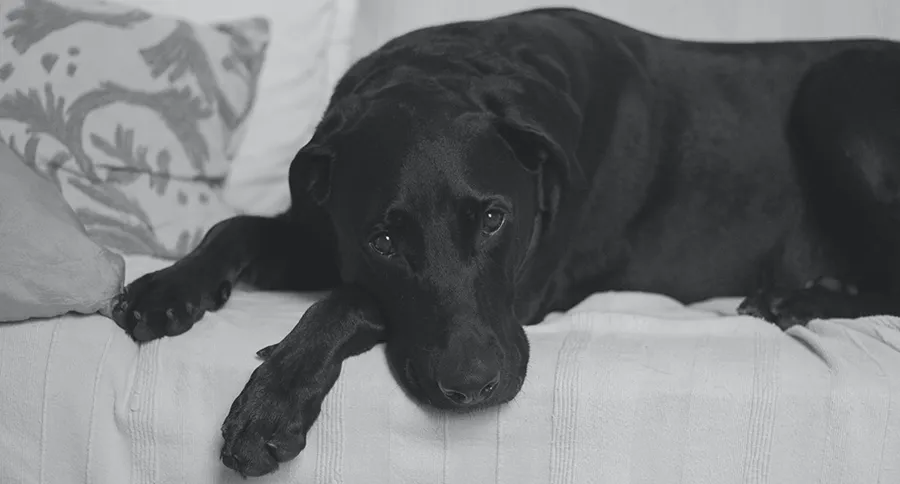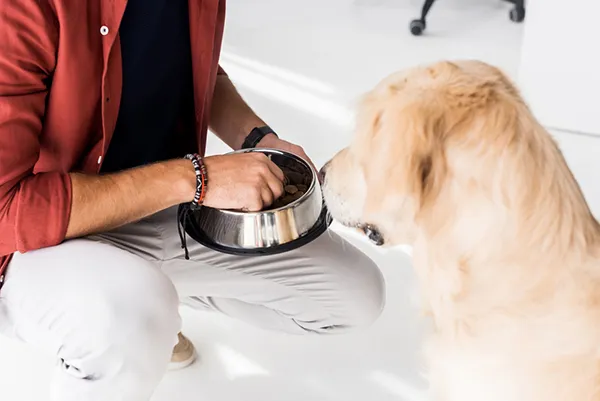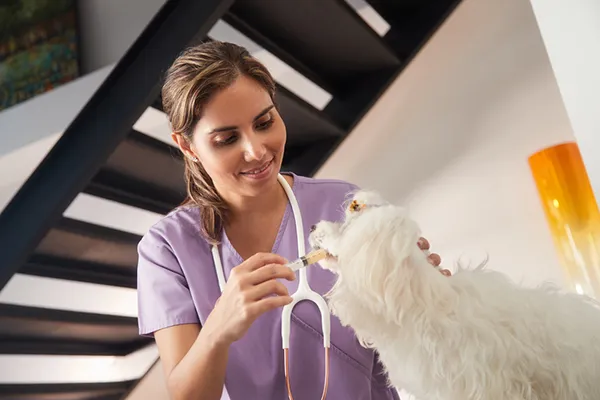Just like humans, dogs can experience a loss of appetite when they’re feeling unwell. A single missed meal might not be a cause for immediate concern, but if your dog consistently refuses food, it’s essential to investigate the underlying reasons. As a devoted pet parent, ensuring your furry friend receives proper nutrition, especially during illness, is paramount for their recovery and overall well-being. This guide will walk you through common reasons for appetite loss, when to seek veterinary attention, and practical strategies for encouraging your sick dog to eat.
Why Your Dog Might Be Refusing Food
A dog’s loss of appetite, medically known as inappetence or anorexia, can stem from various factors, ranging from minor issues to more serious health conditions. Understanding these potential causes can help you determine the best course of action. The most common reasons a dog may lose their appetite include:
- Illness or Infection: Many illnesses, from a simple stomach upset to more complex systemic infections, can cause dogs to lose interest in food. Pain, nausea, and general malaise associated with sickness are significant appetite suppressors.
- Disease: Chronic diseases such as kidney disease, liver disease, cancer, or dental issues can lead to persistent appetite loss. Dental pain, for instance, can make eating very uncomfortable.
- Recovery from Surgery: Post-operative recovery often involves pain medication and general discomfort, which can temporarily reduce a dog’s desire to eat.
- Mourning or Stress: Dogs are highly sensitive creatures. The loss of a companion animal or human family member, or significant changes in their environment (like moving to a new home or a new pet joining the household), can cause stress and depression, leading to appetite suppression.
- Aging: Older dogs may naturally experience a decrease in appetite as their metabolism slows down, or due to age-related health issues.
- Medication Side Effects: Certain medications, including some antibiotics, can have side effects that diminish appetite or cause nausea. Always read medication instructions carefully.
When to Contact Your Veterinarian
While a temporary dip in appetite might not be alarming, certain symptoms coupled with food refusal warrant immediate veterinary attention. Timely intervention can be crucial for your dog’s health. You should contact your veterinarian as soon as possible for an examination and potential testing if your dog exhibits any of the following symptoms in conjunction with a loss of appetite:
- Vomiting: Especially if it’s frequent or severe.
- Lethargy: Unusual tiredness or lack of energy.
- Weight Loss: Noticeable decrease in body mass over a short period.
- Diarrhea: Loose or watery stools, particularly if accompanied by blood or mucus.
- Gagging or Wheezing: Signs of respiratory distress or an obstruction.
- Coughing: Persistent or severe coughing spells.
- Fever: Elevated body temperature.
- Changes in Drinking Habits: Either excessive thirst or refusing to drink.
These symptoms could indicate a serious underlying condition that requires professional diagnosis and treatment.
Effective Methods for Encouraging a Sick Dog to Eat
 A sick Labrador Retriever resting on a white couch.
A sick Labrador Retriever resting on a white couch.
When your dog is ill and reluctant to eat, getting them to consume enough calories and nutrients can be a challenge. Fortunately, there are several methods you can try to stimulate their appetite. The most effective approach often depends on your dog’s specific condition and preferences. Don’t be discouraged if the first method doesn’t work; persistence and trying different techniques are key.
Give Your Dog Time
Sometimes, the simplest solution is to give your dog a little space. Dogs can typically go a few days without food without serious health repercussions, provided they stay hydrated. It’s not uncommon for a dog to skip a meal occasionally, just like humans. Consider leaving their food out for a period, allowing them to graze if and when they feel hungry. However, if more than 24 hours pass, or if other concerning symptoms arise, it’s time to try more proactive measures.
Offer Special Treats
If your dog isn’t feeling well, a highly palatable treat might be just what they need to spark their interest in food. Foods they don’t normally get can be very enticing. Consider offering small amounts of plain, cooked human foods like boiled chicken or even certain meat-based baby foods (ensure no onion or garlic, which are toxic to dogs). Start with a small portion to gauge their interest. If they eat it, you can gradually try mixing a small amount with their regular dry food to encourage them to return to their normal diet. Just be mindful not to overindulge them, as too many treats can upset their stomach further or lead to an unbalanced diet. Exploring what is the best food for dogs to eat might also give you ideas for healthy, appealing options.
Consider a Change in Dry Food or Add Wet Food
If your dog has consistently turned down their regular dry kibble, it might be worth exploring other options. Sometimes, a change of brand can make a big difference in palatability. You could try purchasing a small sample pack from a pet store to see if a different formulation appeals to them more. Alternatively, mixing in some wet dog food can significantly increase the aroma and appeal of their meal, often stimulating the appetite of a finicky or unwell dog.
Warm Up Their Food
Heating your dog’s food, whether it’s dry kibble or wet food, can significantly enhance its aroma and palatability. Dogs rely heavily on their sense of smell to gauge food appeal. When a dog is sick, their sense of smell and taste might be diminished. Gently warming the food can make it more fragrant, drawing your dog in and encouraging that crucial first bite, which can then lead to them finishing the meal.
Add Broth for Extra Flavor
Beyond simply warming food, adding a splash of warm broth can provide an enticing boost of flavor. If your dog has grown tired of their current food’s taste or is experiencing a reduced sense of taste due to illness, broth can make it irresistible. Opt for plain, low-sodium chicken or beef broth, ensuring there are no added onions or garlic. This extra flavor can be the key to getting them to eat again. For more insights on nutritious choices, you might consider what is the best thing for dogs to eat.
Hand-Feed Your Dog
 A dog owner gently hand-feeding their dog individual pieces of food.
A dog owner gently hand-feeding their dog individual pieces of food.
Sometimes, a personal touch can make all the difference. Try hand-feeding individual pieces of food to your pet. The act of being comforted and encouraged by you can sometimes motivate a sick dog to eat. This process might be slow initially, but with patience, your dog may gradually transition to eating from their bowl on their own.
Check Medication Instructions
As mentioned, some medications can cause a decrease in appetite. If your dog is currently on antibiotics or any other prescription, carefully review the instructions. Some medications should be given with food, while others are best given on an empty stomach, or require a waiting period before offering food. Waiting at least fifteen minutes after administering certain medicines can ensure the medication has settled in their stomach, potentially reducing nausea before food is introduced.
Allowing Your Dog to Eat Grass
 Two brown dachshund dogs eating grass in a field.
Two brown dachshund dogs eating grass in a field.
It might seem counterintuitive, but if your dog is refusing their regular food but shows interest in eating grass, it’s generally okay to let them. Dogs sometimes eat grass when they have an upset stomach, as it can induce vomiting, which may relieve discomfort. If whatever is making your dog feel ill can be eased by vomiting, their instincts might be guiding them. Ensure your dog remains well-hydrated, especially if they vomit. However, if your dog vomits more than twice, or consistently eats grass every time they’re outside, it’s a clear sign to consult your vet.
When to Seek Veterinary Care
If, despite your best efforts, your dog continues to refuse food or their condition worsens, a visit to the veterinarian is always the best course of action. Your vet can accurately diagnose what is ailing your dog and recommend the most appropriate treatment. They can also prescribe medications, such as anti-nausea drugs or appetite stimulants, to help your dog feel better and encourage them to eat. This is crucial for their recovery and to prevent further complications like dehydration or malnutrition.
Appetite Stimulants
If your dog has a prolonged period of food refusal or a health condition that severely suppresses their appetite, your veterinarian might recommend or prescribe a medicinal appetite stimulant. These can work in different ways: some reduce nausea, making food more appealing, while others mimic natural hormones that trigger hunger. For a safe and effective approach, it’s vital that you and your vet first identify the root cause of your dog’s appetite loss to ensure the correct stimulant is used.
Syringe Feeding as a Last Resort
Syringe feeding is a more drastic measure and should only be considered if other methods have failed and after consulting with your veterinarian. If your dog hasn’t eaten in two days, you can try feeding them liquids like broth or watered-down wet food using a syringe. If your vet has prescribed medication in liquid form, a syringe can also be used for administration. It’s paramount to perform syringe feeding correctly to avoid aspiration pneumonia or other negative health effects. Your veterinarian can demonstrate the proper technique during an examination.
Optimal Foods to Feed a Sick Dog
When your dog is unwell, choosing the right food is crucial. Certain foods are not only more appetizing but also easier on an upset stomach, providing essential nutrients without causing further distress.
Wet Dog Food
For dogs accustomed to dry kibble, introducing wet food can be an exciting and enticing change. Many dogs find wet food highly palatable due to its stronger aroma and softer texture. An added benefit is its higher water content, which helps keep your dog hydrated, especially important when they are not drinking enough.
Baby Food (Meat-Based)
Plain, meat-based baby food can be a good option for sick dogs. It’s easy to digest, palatable, and can be quite nutritious. Look for varieties that contain only chicken, lamb, or turkey, and absolutely avoid any baby food with onion or garlic powder, as these are toxic to dogs. Ensure there are no other artificial ingredients or excessive sugars.
Bone Broth
Bone broth is a wonderfully mild yet nutritious option for dogs with suppressed appetites or upset stomachs. It’s easy to digest and provides essential minerals and hydration. A good quality, plain bone broth can be very comforting and a gentle way to introduce nutrients when your dog is refusing solid food.
Chicken Broth
Similar to bone broth, plain chicken broth (low-sodium, no onion or garlic) can be a great way to entice a sick dog to eat. Its appealing flavor can stimulate their appetite, and it’s gentle on an upset stomach. It also contributes to their hydration, which is vital during illness.
Shredded Chicken
Boiled, unseasoned shredded chicken is often a favorite among dogs. It’s bland, easy to digest, and highly palatable, making it a strong incentive for a sick dog to eat. Ensure the chicken is thoroughly cooked and shredded into small, manageable pieces to prevent choking. When thinking about protein sources, you might also be curious about what meat can I feed my dog.
Chicken and Rice
A classic go-to for upset stomachs, a bland diet of boiled chicken and white rice is easy to digest and gentle on the gastrointestinal system. Always boil the chicken without any seasoning and ensure the white rice is thoroughly cooked. This combination provides easily digestible carbohydrates and protein, supporting recovery.
Pumpkin (Canned, Plain)
Pumpkin is renowned for its digestive benefits, being high in fiber and packed with vitamins like A, C, iron, and magnesium. Offer your dog plain, canned pumpkin (not pumpkin pie filling, which contains sugars and spices that can worsen an upset stomach). A serving of about four tablespoons for medium-sized dogs can aid digestion and provide a nutrient boost.
The Importance of Hydration
While focusing on food intake is natural, maintaining your dog’s hydration is arguably even more critical, especially when they are unwell. Dogs can survive longer without food than without water. A dog can typically go up to three days without water, but only five to seven days or more without food. Realistically, you should never test these limits. If your dog is not drinking for 48 hours or more, immediate veterinary attention is crucial. Never force your dog to drink, as this can lead to aspiration pneumonia.
Strategies to Encourage Water Intake
If your dog is showing little interest in drinking water, try these tricks to encourage hydration:
- Ice Cubes: Offer an ice cube for your dog to lick. Many dogs find this refreshing and fun.
- Water on Fingers: Gently offer water from your fingertips. Sometimes the direct interaction encourages them.
- Pedialyte: Consult your vet before offering Pedialyte. If approved, it can help replenish electrolytes.
- Add Ice to Bowl: The clinking sound and cooler temperature can sometimes make water more appealing.
Recognizing Signs of Dehydration
Vigilance for signs of dehydration is essential. Familiarize yourself with these common symptoms:
- Loss of Appetite: This often accompanies dehydration.
- Panting: Excessive or unusual panting.
- Lethargy: Extreme tiredness or weakness.
- Loss of Skin Elasticity: When you gently pull up the skin on their back, it should snap back quickly. If it stays tented, they may be dehydrated.
- Dry and Sticky Gums: Gums should be moist and slick; if they feel dry or tacky, it’s a sign of dehydration.
- Dry Nose and Eyes: A normally moist nose and bright eyes may appear dry.
Seek immediate veterinary attention if your pet shows any signs of dehydration. Your veterinarian can administer subcutaneous fluids to rehydrate them while addressing the underlying cause of their sickness.
What Not to Feed a Dog, Especially When Sick
When your dog is sick, their digestive system is already compromised, making it even more important to avoid foods that could cause further issues. Sometimes, illness can even stem from consuming rich or inappropriate foods. It’s crucial to ensure your sick dog doesn’t have access to potentially harmful items. For a broader understanding of what to avoid, consider learning about what foods can german shepherds not eat, as many of these apply to all breeds.
Here’s a list of foods to avoid and why:
| Don’t Feed Your Dog: | Because… |
|---|---|
| Xylitol | Can cause a rapid drop in blood sugar and liver failure. |
| Avocado | Seeds can cause obstruction; the fruit contains persin, toxic in large amounts. |
| Grapes or Raisins | Highly toxic, can cause acute kidney failure. |
| Caffeine | Found in coffee, tea, chocolate; can be fatal. |
| Onions or Garlic | Can cause red blood cell damage (anemia) and poisoning. |
| Alcohol | Highly toxic, can cause vomiting, diarrhea, breathing problems, coma, and death. |
| Milk or Other Dairy | Many dogs are lactose intolerant, leading to diarrhea and digestive upset. |
| Human Medication | Can cause severe illness, overdose, and potentially death. |
| Chocolate | Contains theobromine, toxic to dogs, causing vomiting, diarrhea, tremors, seizures, and death. |
| Sugar | Sugary foods can cause weight gain, dental problems, and diabetes. |
| Macadamia Nuts | Can cause weakness, vomiting, tremors, and hyperthermia. |
| Raw Eggs | Risk of salmonella, E. coli, and avidin (interferes with biotin absorption). |
| Raw Fish or Meat | Risk of bacterial infections (salmonella, E. coli) and parasites. |
| Uncooked Yeast Dough | Can rise in the stomach, causing bloating and pain, or produce alcohol. |
| Fat Trimmings | High fat content can lead to pancreatitis. |
| Spices, Baking Powder, or Baking Soda | Many spices are toxic; baking powder/soda contain sodium bicarbonate, harmful in large amounts. |
| Bones | Can cause choking, splinter and cause internal injuries, or obstruction. |
| Fruits with Seeds or Pits | Seeds and pits can contain cyanide (apples, cherries) or cause digestive obstruction. |
| Salt | Too much salt can lead to sodium ion poisoning, causing vomiting, diarrhea, tremors, seizures, and even death. |
Frequently Asked Questions About Feeding a Sick Dog
When Shouldn’t I Feed My Sick Dog?
If your dog has been experiencing vomiting or diarrhea, it’s generally best to withhold food for at least twelve hours after the last episode. Feeding them too soon can further upset their stomach and trigger another round of vomiting or diarrhea. Always ensure they have access to fresh water during this time. If vomiting or diarrhea persists for two days or more, consult your veterinarian promptly.
How Much Should I Feed My Sick Dog?
 A Golden Retriever peacefully laying on a cozy bed.
A Golden Retriever peacefully laying on a cozy bed.
The amount of food to offer a sick dog depends on their size, the nature of their illness, and their individual appetite. It’s crucial to consult with your vet for specific feeding guidelines. In general, start with small, frequent meals rather than large ones. Let your dog guide you: if they eat some but then refuse more, wait a while before offering food again. Gradually increase the quantity as their appetite improves.
Do Sick Dogs Lose Their Sense of Smell?
While a dog’s sense of smell is incredibly powerful, various factors can influence it. Allergies, infections (especially respiratory ones), and old age can all diminish a dog’s olfactory abilities. A dry nose can also temporarily decrease their sense of smell. However, illness itself doesn’t automatically mean a complete loss of smell, though a general feeling of unwellness might make them less interested in food, regardless of its aroma.
What Else Can I Do to Help My Dog Feel Better?
Beyond feeding, ensure your dog is as comfortable as possible. Provide a soft, clean bed in a quiet, warm spot where they can rest undisturbed. If they feel up to it, short, gentle walks might be beneficial. Most importantly, try to remain calm and reassuring. Dogs are highly attuned to human emotions; if you’re stressed, they’re likely to pick up on it, which can exacerbate their own anxiety. Your calm presence can be a powerful comfort.
How Long Can a Dog Go Without Food?
Dogs can typically go three to five days without food, but this is far from ideal and should not be tested. If your dog has gone two full days without eating, it is highly recommended to call a veterinarian immediately if you haven’t already. As highlighted earlier, water intake is even more crucial. While you shouldn’t force-feed water, persistently encourage them to drink.
Should I Feed My Dog Immediately After They Throw Up?
No, it’s best to withhold food for a few hours (at least 6-12 hours) after your dog has vomited. This waiting period allows their stomach to settle and gives you time to observe if the vomiting continues or if other concerning symptoms appear. Always ensure fresh water is available, even if they’ve just thrown up, as dehydration is a significant concern.
Should You Force-Feed a Sick Dog?
 A veterinary technician gently force-feeding a dog using a syringe.
A veterinary technician gently force-feeding a dog using a syringe.
Force-feeding a sick dog, typically using a syringe, should only be considered as a last resort and strictly after consultation and demonstration by your veterinarian. If your dog has not eaten for more than 48 hours, your vet might deem it necessary. It’s crucial to learn the correct and safe technique from your veterinarian to avoid complications like aspiration. They can demonstrate how to safely administer liquid food or medication.
What to Do After 48 Hours Without Food
If your dog is still refusing food after 48 hours, it’s imperative to seek immediate veterinary care. At this point, the risk of dehydration, malnutrition, and worsening underlying conditions becomes severe. An expert team of veterinary professionals can provide intravenous fluids, conduct comprehensive diagnostics to pinpoint the cause of appetite loss, and initiate appropriate treatment to help your furry friend recover before their condition deteriorates further. Early intervention can make a significant difference in your dog’s prognosis.
